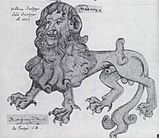Manticore facts for kids
Manticores are scary creatures from Greek mythology. Imagine a beast with the body of a strong lion, the head of a human, and three rows of sharp teeth like a shark! In many stories, they also had a tail like a dragon or a scorpion. Some tales even say they could shoot poisonous spikes from their tails. Ancient Greeks sometimes believed that if someone went missing, a manticore might be the cause!
Contents
What's in a Name?
The word "manticore" comes from an old Persian word. It means "man-eater." This name was first written down by a Greek doctor named Ctesias. He lived in Persia a long, long time ago and heard about these creatures from people who had traveled to India. He wrote that the Persian name for this beast meant "man-eater" in Greek. Over time, the name changed slightly to "manticore" as it was passed through different writings.
Manticores in Heraldry
What is Heraldry?
Heraldry is a system of symbols and designs, often used on shields, flags, or badges. These symbols helped people identify families, knights, or groups in the past.
Manticore Symbols
Manticores, or similar creatures, have been used as symbols in heraldry for many centuries. They first appeared in English heraldry around the year 1470. For example, William Hastings, 1st Baron Hastings used a manticore as his special badge.
Later, in the 16th century, other important people like Robert Radcliffe, 1st Earl of Sussex and Sir Anthony Babington also used the manticore as a symbol. Sometimes, the name for these creatures in heraldry changed to "mantyger" or "mantiger."
Heraldic manticores usually have the body of a wild animal. Sometimes they are shown with dragon feet or even human feet. They often have the face of an old man and sometimes even spiraling horns.
Manticores in Popular Culture
Manticores still appear in many stories, games, and shows today!
- In games like Dungeons & Dragons and Magic: The Gathering, manticores are often shown with large wings, allowing them to fly.
- Two manticores can be seen in the cartoon My Little Pony: Friendship Is Magic. They have a lion's head, dragon wings, and a scorpion tail.
- A manticore is a main character in the music album Tarkus by the band Emerson, Lake & Palmer.
- In the video game Dark Souls DLC, a manticore-like creature is called the "Sanctuary Guardian."
- A CGI animated manticore was featured in a 2010 episode of the BBC show Merlin, called "Love in the Time of Dragons."
Images for kids
-
Woodcut from Edward Topsell's The Historie of Foure-footed Beastes (1607)
-
Manticore at the Church of St Mary and St David, Kilpeck, Herefordshire (12th century)
-
Manticore in British Library Royal MS 12.C.xix (1200–1210)
See also
 In Spanish: Mantícora (mitología) para niños
In Spanish: Mantícora (mitología) para niños








